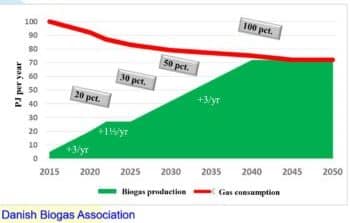
9. The pathway to 100% biomethane in the grid by 2040
There is no net zero without biogas / positive impacts quantified / structural policy issue / 1TWh a year growth forecast / tiered support system on table /

The Danish biogas industry aims to have 100% renewable gas – biomethane – in the grid by 2040. Five years later than anticipated as a result of uncertainty over what will replace the current subsidy regime when it closes in 2022.
Yet despite their being a void where subsidies should be the industry remains confident of hitting the target. Bruno Nielsen is the chief operating officer of the Danish Biogas Association. He says, ’After 2022, it’s wait and see but we’re confident a new form of support will materialise, not least because of the country’s ambitions to achieve net zero.’
A recent report from Green Gas Denmark concluded that the complete conversion to green gas would bring about important benefits for society, including:
- Displacement of 4.6 million tons of CO2 by 2035 (now revised to 2040);
- An optimal use of the state-owned gas system – a social investment of DKK 55 billion;
- The development of a strong vibrant Danish green gas industry with potentially up to 20,000 new jobs and DKK 16 billion in exports by 2035;
- Conversion of the heavy transport fleet to green gas reducing CO2 and NOx emissions;
- Circular economy benefits including lower emissions in agriculture;
- Decentralised, CO2 neutral indigenous gas production.

‘Biogas has a reputation for being expensive, but we resolve a lot of other challenges,’ says Bruno. ‘The environment is better with biogas. It reduces greenhouse gas emissions, and eutrophication of the waterways. We’ve got a gas grid and we can turn to green gas.”
The current hiatus in support he suggests reflects a structural issue within government. This being that the ministry of energy pays the cost of supporting biogas while the ministries of agriculture and environment reaps the rewards. As a consequence, support for biogas can become a departmental football.
Several replacements are being considered to replace the current subsidy regimes. Renewable obligations are one. Another is tax exemptions for using biogas in the heat and transport sectors, where biogas can have a greater environmental and climate impact. A three-tier system is also on the table, rewarding operators on a sliding scale depending on their processes.
Under this system operators would receive a base rate tariff for treating manures, a higher rate if they also upgrade to biomethane, and a top rate if they are producing transport fuels.
Bruno says, ‘Biogas is the cheapest green gas although more costly to operate. For wind and solar the cost is primarily the construction. There is, however, no greater way to mitigate GHGs than biogas. It is a win-win. It delivers clean energy while cutting air and climate pollution from hard to reach sectors, heat, transport and agriculture.’

The DBA has 160 members, over 60 of whom are biogas plant operators. Thirty-two currently produce biomethane for the grid and a similar number produce biogas for use locally either through a district heat network or CHP. A good number are expected to switch to upgrading from producing electricity as the incentives are better. In Denmark support is given to the use not the production of biogas.
With the number of developments in the pipeline biogas production is set to increase by around 1TWh (3PJ) each year until 2022, the cut off for commissioning. That will bring the level of renewable gas in the gas grid to 30%.
Then it is predicted biogas development will be stalled until new incentives are adopted. ‘If we then go back to +3 PJ from 2025, we will pass 50 per cent in 2030 and 100 per cent in “2040”. It could have been 2035 if we hadn’t lost pace.’
The DBA has mapped the feedstock availability in Denmark to prove the target is deliverable. It is an approach the organisation pursues across the board. ‘We use data and calculations not long reports to direct growth of the industry,’ says Bruno.
Given the jobs and economic benefits that biogas delivers alongside its contribution to achieving net zero, and the government’s admission that companies are ahead of the game in the green transition, it seems more a question of when and in what form future support will materialise than if.
You must be logged in to view the rest of the content on this page.
To request a login and password, contact us at info@worldbiogasassociation.org
If you have login details, please enter them below.

